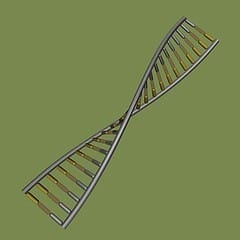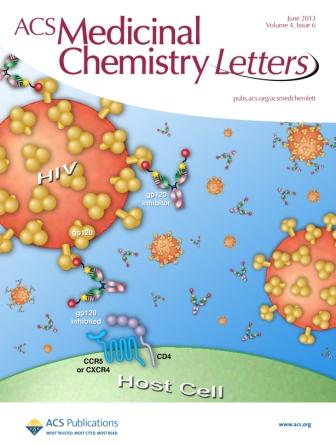
How chewing gum or a shed hair can let strangers read your ‘Book of Life’
Someone finds that piece of chewing gum you pitched today, uses the saliva to sequence your DNA and surreptitiously reads your book of life — including genetic secrets like your susceptibility to diseases. If that scenario, posed in an article in the current edition of Chemical & Engineering News, causes a little discomfort, consider this: That stranger also uses the DNA to reconstruct a copy of y-o-u.
Linda Wang, a senior editor of C&EN, the weekly newsmagazine of the American Chemical Society, the world’s largest scientific society, focuses on an unusual art exhibition that raises those and other unsettling questions. The exhibit, “Stranger Visions,” contains the work of Heather Dewey-Hagborg, a Ph.D. candidate in electronic arts at Rensselaer Polytechnic Institute.
Wang explains that at a time of concern and debate about the privacy of email and other personal communications, Dewey-Hagborg raises some of what may be the ultimate personal privacy issues. Dewey-Hagborg actually used genetic analysis and three-dimensional printing technology to produce facial sculptures of anonymous strangers. She collected their DNA from chewing gum, cigarette butts, strands of hair and other items that people have left behind in subways, bathrooms and other public places around New York City.
The Latest Bing News on:
Guarding Our DNA
- Is the ocelot, the endangered South Texas wildcat, making a comeback?on April 27, 2024 at 11:00 am
Conservation groups found a sign of hope in DNA test of ocelot found in Hidalgo, but scientists say it’s too soon to celebrate.
- Fire Country Season 2 Episode 7 Review: A Hail Maryon April 26, 2024 at 7:00 pm
Our review of Fire Country Season 2 Episode 7 captures the episode's redemption story supported by loyalty, respect, sacrifice, and life-threatening excitement.
- A plan to solve cold cases in Florida is underwayon April 26, 2024 at 4:51 pm
The bill (HB 533), is being touted as a public safety initiative to help solve thousands of unsolved mysteries. The measure was backed by Miami Republican Representative Tom Fabricio. “Back in 2011, ...
- ‘Grateful for him’: World War 2 Veteran’s remains return home decades lateron April 25, 2024 at 8:42 pm
Noah Reeves got a well deserved hero's welcome home at the Birmingham Airport Thursday. A casket draped in the American flag carrying his remains was escorted by an honor guard into a hearse before a ...
- Q&A with new ODU basketball coach Mike Jones: ‘This is going to be fun’on April 25, 2024 at 1:48 pm
Mike Jones was introduced as Old Dominion’s 14th head men’s basketball coach on March 1 at a press conference inside Chartway Arena. Since then, the former Monarchs guard has spent his time moving to ...
- Wheeling Park High celebrates military signing day with 10 senior enlistmentson April 25, 2024 at 11:25 am
Wheeling Park High School hosted its annual military signing day as 10 are set to enlist after graduation.Two handfuls of graduating seniors have signed up to f ...
- Lock WW II vet returns home — after 80 yearson April 24, 2024 at 4:24 pm
The remains of Lock veteran Wayne D. Crowl were identified through DNA testing. His family will inter the remains on April 26, 2024.
- Arkansas Supreme Court ruling could allow new DNA testing for West Memphis Three caseon April 18, 2024 at 11:15 am
An Arkansas Supreme Court ruling has opened the door for new DNA testing in the West Memphis Three case. LITTLE ROCK, Ark. — The Arkansas Supreme Court has reversed and remanded a circuit court ruling ...
- ‘We trusted the way of Pep’ – Germany legend claims country has completely lost its DNA after Guardiola ‘mistake’on April 18, 2024 at 7:07 am
A BAYERN MUNICH legend has claimed that Germany lost its DNA due to Pep Guardiola’s spell at Bayern Munich. The Spanish coach won the lot at Barcelona during his four years in charge with his ...
- DNA: Did cloud seeding drown Dubai?on April 17, 2024 at 1:05 pm
The amount of rainfall that occurs in Dubai in one and a half years has occurred in just 24 hours which has ruined a fast-paced city like Dubai. Boats are moving on the streets of Dubai. Airport, ...
The Latest Google Headlines on:
Guarding Our DNA
[google_news title=”” keyword=”Guarding Our DNA” num_posts=”10″ blurb_length=”0″ show_thumb=”left”]
The Latest Bing News on:
Personal privacy
- Why Apple Mac Users Should Invest in a VPN: Protecting Your Data and Privacyon April 27, 2024 at 1:09 am
The current era of online security is a scary thing, with users’ privacy being under constant threat. Now, it’s become almost essential to safeguard personal ...
- DOJ Arrests Bitcoin Wallet Founders Amid Cash-Like Privacy Concernson April 26, 2024 at 5:30 am
Advocates for regulation argue that cryptocurrencies could become safe havens for criminals without rules. They cite cases like Silk Road, where bitcoin was used for illegal goods transactions. By ...
- Managers: You’re not a BFF or a therapist. This is how much you should know about your employees’ personal liveson April 25, 2024 at 2:30 pm
the ideal boss isn’t your best friend or someone who cannot appreciate the boundaries between your personal life and professional self.
- The AI camera stripping away privacy in the blink of an eyeon April 25, 2024 at 7:00 am
A new camera called NUCA uses artificial intelligence to create deepfake photos of subjects by stripping away clothing in close to real time.
- Dashboard confessions: unveiling the privacy issues in connected carson April 25, 2024 at 5:45 am
Sara H. Jodka of Dickinson Wright PLLC discusses the privacy risks posed by connected cars, vehicles with internet connectivity allowing for collection of data on drivers' behaviors.
- Colorado enacts groundbreaking brain data privacy lawon April 24, 2024 at 6:15 pm
Colorado became the first state in the nation to enact a law protecting neural data, emphasizing the growing intersection of technology and human biology while ensuring privacy in the expanding field ...
- NPR Online Privacy Policyon April 23, 2024 at 5:10 pm
Welcome to the NPR Privacy Policy. This Privacy Policy describes the personal information National Public Radio, Inc. and its affiliated organizations (collectively ...
- AI can predict political orientation from blank faces — posing ‘threatening’ privacy challengeson April 23, 2024 at 8:48 am
Researchers are warning that facial recognition technologies are “more threatening than previously thought” and pose “serious challenges to privacy.” ...
- Biden administration issues new rule to protect privacy of those seeking reproductive health care: ‘No one should have to live in fear’on April 22, 2024 at 10:22 am
Patients have a right to privacy when it comes to their medical information, even when they travel to another state for an abortion, IVF, birth control or other types of reproductive health care, ...
- LexisNexis Hit With Privacy Class Action Over Alleged Use of PII to 'Turn a Profit'on April 18, 2024 at 7:19 am
and personal property,” which the lawsuit claims “runs afoul of the well-established right of privacy of at least the residents of California and Illinois.” Lexis personal records products. Courtesy ...
The Latest Google Headlines on:
Personal privacy
[google_news title=”” keyword=”personal privacy” num_posts=”10″ blurb_length=”0″ show_thumb=”left”]











